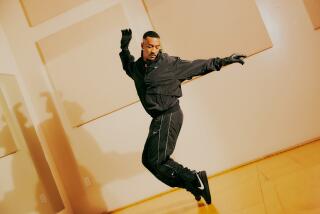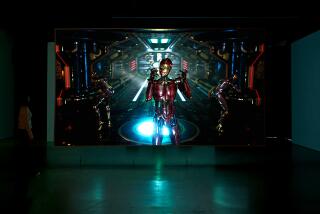Trey McIntyre Project brings ‘Ways of Seeing’ to Segerstrom
Trey McIntyre recalls the time he played the Pied Piper of Orange County. The choreographer had brought his dance troupe and his dance, “The More I See You,” to the Segerstrom Center for the Arts in 2009. “As I left the theater, I turned into a caricature of a choreographer. Someone handed me a cape, a glass of scotch, and a pair of greyhounds. The paparazzi hounded me. I transformed into a hard-boiled pulp-fiction guy.”
Astonishingly, he remembers, “the audience followed.”
Jump ahead to this weekend’s return visit of Trey McIntyre Project, featuring the world premiere of “Ways of Seeing,” a Segerstrom commission that also puts the audience into active mode. The multimedia work begins in Segerstrom Hall and moves to the center’s Arts Plaza. So wear your walking shoes.
The choreographer won’t reveal his audience evacuation plan. “The surprise is important, a big part of the experience,” he says. “I enjoy moving bodies through space, period. I’m fascinated by how traffic patterns move, how people interact, the construct of moving people. There are conventions of how people enter and exit a theater.”
McIntyre and his 10-member Trey McIntyre Project have enlivened Boise, Idaho, the city of 206,000 they adopted as their base five years ago. But one of their regular homes away from home is Costa Mesa. This week the troupe is spending Thanksgiving here, teaching master classes and gearing up for weekend performances.
Chatting last week by phone from New York in the midst of his company’s Brooklyn Academy of Music (BAM) performances, McIntyre, 42, explains that “Ways of Seeing,” concerns theatrical conventions. “The piece explores the roles of audience and performer and seeks to invert that and give a different perspective. I like to move things and observe how reality changes.”
Segerstrom Center’s executive vice president (and its dance doyenne) Judy Morr professes delight at the prospect of coaxing her dance-faithful from the cozy confines of their chairs. She specifically commissioned McIntyre to create “Ways of Seeing” as an indoor-outdoor event. “He’s a master at that.”
Audience interaction, once a hallmark of experimental theater, has entered the mainstream. “There’s a change in performing arts across the country, a way to make certain that the arts stay alive and connected to the community,” says Morr.
Trey McIntyre Project’s personal panache adds to its allure for Ella Baff, artistic director of Jacob’s Pillow Dance Festival, where the company has regularly performed since 2005. “They’re a magnet for audiences. It’s the vitality they project on stage. Trey’s such a package. He’s handsome, articulate, gracious, a special person. He’s a leader in the arts field.”
Another Friend-of-Trey in Southern California is Jodie Gates, artistic director of the Laguna Dance Festival. The two go back to the late ‘90s when McIntyre fashioned a solo for Gates, then a ballerina with Pennsylvania Ballet. She notes, “He represents American dance now. I like his threading with pop culture. And he knows his craft.”
Turns out, he also knows comedy. Among the Costa Mesa program’s three other works is “The Unkindness of Ravens,” a Segerstrom co-commission with BAM in collaboration with the Korea National Contemporary Dance Company. The work examines culture gaps in humor. The company’s sly “Gangnam Style” Boise airport greeting to three visiting Korean dancers, now making the YouTube rounds, shows McIntyre’s penchant for the absurd.
“As an artist, I’m drawn to darker parts,” he says. “I’m into comedians. It’s a brand new era. Comics hold our hand and lead us into dark, scary places. In my piece I explore the survival mechanism of humor, and other animal instincts, through ravens. They are the one animal we know has a sense of humor.”
“Unkindness” received the kindness of New York critics. That’s two major premieres within two weeks for McIntyre — one, each, in New York and California. McIntyre’s career path has also forged a web of working relationships in the nation’s heartland.
Born in Wichita, Kan., McIntyre studied at the North Carolina School of the Arts and at the Houston Ballet Academy. Joining the Houston Ballet as a dancer in 1990, he apprenticed as the company’s junior choreographer. He received mentorship from Ben Stevenson, his artistic director. McIntyre churned ballets, mixing the rigor and precision of ballet with the invention of contemporary dance.
After a decade of serious craft-honing, he served as resident choreographer for Oregon Ballet Theatre, Ballet Memphis and the Washington Ballet. His freelance portfolio crammed with 90 works for the likes of Stuttgart Ballet, Hubbard Street Dance Chicago and New York City Ballet, McIntyre formally launched Trey McIntyre Project.
Remember 2008? The year of the economic downturn? That’s right when McIntyre made Boise his low-cost base, a move now considered an art-world success. Boiseans like Trey McIntyre Project too. “They treat us like rock stars,” says McIntyre. Reviewing “Ravens” in advance of its New York premiere, the Boise Weekly praised McIntyre’s “biting mockery,” his “brutal take on man’s animalistic nature,” and his ability to “[bring] together big ideas and minute observations through dance.”
MORE
INTERACTIVE: Christopher Hawthorne’s On the Boulevards
TIMELINE: John Cage’s Los Angeles
PHOTOS: Arts and culture in pictures
More to Read
The biggest entertainment stories
Get our big stories about Hollywood, film, television, music, arts, culture and more right in your inbox as soon as they publish.
You may occasionally receive promotional content from the Los Angeles Times.






